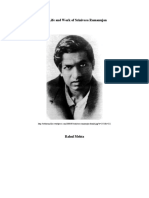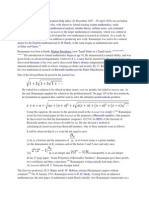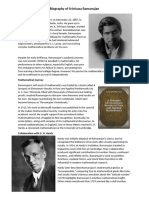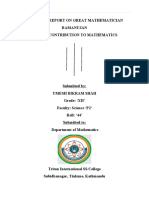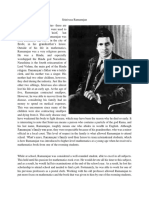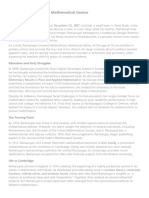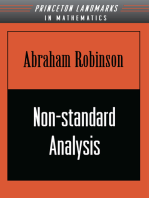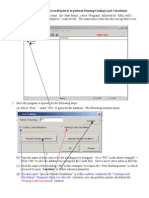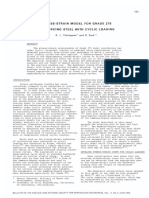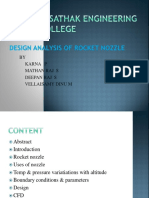Was An Indian Mathematician and Autodidact Who
Was An Indian Mathematician and Autodidact Who
Uploaded by
Sangeeth KumarCopyright:
Available Formats
Was An Indian Mathematician and Autodidact Who
Was An Indian Mathematician and Autodidact Who
Uploaded by
Sangeeth KumarOriginal Title
Copyright
Available Formats
Share this document
Did you find this document useful?
Is this content inappropriate?
Copyright:
Available Formats
Was An Indian Mathematician and Autodidact Who
Was An Indian Mathematician and Autodidact Who
Uploaded by
Sangeeth KumarCopyright:
Available Formats
was an Indian mathematician and autodidact who, with almost no formal training in pure mathematics, made extraordinary contributions
to mathematical analysis, number theory, infinite series, and continued fractions. Living in India with no access to the larger mathematical community, which was centered in Europe at the time, Ramanujan developed his own mathematical research in isolation. As a result, he sometimes rediscovered known theorems in addition to producing new work. Ramanujan was said to be a natural genius by the English mathematician G.H. Hardy, in the same league as mathematicians like Euler and Gauss.[1] Born in a poor Brahmin family, Ramanujan's introduction to formal mathematics began at age 10. He demonstrated a natural ability, and was given books on advanced trigonometry written by S. L. Loney that he mastered by the age of 12; he even discovered theorems of his own, and re-discovered Euler's identity independently.[2] He demonstrated unusual mathematical skills at school, winning accolades and awards. By 17, Ramanujan had conducted his own mathematical research on Bernoulli numbers and the EulerMascheroni constant. He met deputy collector V. Ramaswamy Aiyer, who had recently founded the Indian Mathematical Society.[38] Ramanujan, wishing for a job at the revenue department where Ramaswamy Aiyer worked, showed him his mathematics notebooks. As Ramaswamy Aiyer later recalled: I was struck by the extraordinary mathematical results contained in it [the notebooks]. I had no mind to smother his genius by an appointment in the lowest rungs of the revenue department.[39] Ramaswamy Aiyer sent Ramanujan, with letters of introduction, to his mathematician friends in Madras.[38] Some of these friends looked at his work and gave him letters of introduction to R. Ramachandra Rao, the district collector for Nellore and the secretary of the Indian Mathematical Society.[40][41][42] Ramachandra Rao was impressed by Ramanujan's research but doubted that it was actually his own work. Ramanujan mentioned a correspondence he had with Professor Saldhana, a notable Bombay mathematician, in which Saldhana expressed a lack of understanding for his work but concluded that he was not a phony.[43] Ramanujan's friend, C. V. Rajagopalachari, persisted with Ramachandra Rao and tried to quell any doubts over Ramanujan's academic integrity. Rao agreed to give him another chance, and he listened as Ramanujan discussed elliptic integrals, hypergeometric series, and his theory of divergent series, which Rao said ultimately "converted" him to a belief in Ramanujan's mathematical brilliance.[43] When Rao asked him what he wanted, Ramanujan replied that he needed some work and financial support. Rao consented and sent him to Madras. He continued his mathematical research with Rao's financial aid taking care of his daily needs. Ramanujan, with the help of Ramaswamy Aiyer, had his work published in the Journal of Indian Mathematical Society.[44] One of the first problems he posed in the journal was:
He waited for a solution to be offered in three issues, over six months, but failed to receive any. At the end, Ramanujan supplied the solution to the problem himself. On page 105 of his first notebook, he formulated an equation that could be used to solve the infinitely nested radicals problem.
Using this equation, the answer to the question posed in the Journal was simply 3.[45] Ramanujan wrote his first formal paper for the Journal on the properties of Bernoulli numbers. One property he discovered was that the denominators (sequence A027642 in OEIS) of the fractions of Bernoulli numbers were always divisible by six. He also devised a method of calculating Bn based on previous Bernoulli numbers. One of these methods went as follows: It will be observed that if n is even but not equal to zero, On the spring of 1913, Narayana Iyer, Ramachandra Rao and E. W. Middlemast tried to present Ramanujan's work to British mathematicians. One mathematician, M. J. M. Hill of University College London, commented that Ramanujan's papers were riddled with holes.[53] He said that although Ramanujan had "a taste for mathematics, and some ability", he lacked the educational background and foundation needed to be accepted by mathematicians.[54] Although Hill did not offer to take Ramanujan on as a student, he did give thorough and serious professional advice on his work. With the help of friends, Ramanujan drafted letters to leading mathematicians at Cambridge University.[55] The first two professors, H. F. Baker and E. W. Hobson, returned Ramanujan's papers without comment.[56] On 16 January 1913, Ramanujan wrote to G. H. Hardy. Coming from an unknown mathematician, the nine pages of mathematics made Hardy initially view Ramanujan's manuscripts as a possible "fraud".[57] Hardy recognised some of Ramanujan's formulae but others "seemed scarcely possible to believe".[58] One of the theorems Hardy found so incredible was found on the bottom of page three (valid for 0 < a < b + 1/2):
Hardy was also impressed by some of Ramanujan's other work relating to infinite series:
In mathematics, there is a distinction between having an insight and having a proof. Ramanujan's talent suggested a plethora of formulae that could then be investigated in depth later. It is said that Ramanujan's discoveries are unusually rich and that there is often more to them than initially meets the eye. As a by-product, new directions of research were opened up. Examples of the most interesting of these formulae include the intriguing infinite series for , one of which is given below
This result is based on the negative fundamental discriminant d = 458 with class number h(d) = 2 (note that 571358 = 26390 and that 9801=9999; 396=499) and is related to the fact that
Compare to Heegner numbers, which have class number 1 and yield similar formulae. Ramanujan's series for converges extraordinarily rapidly (exponentially) and forms the basis of some of the fastest algorithms currently used to calculate . Truncating the sum to the first term also gives the approximation for , which is correct to six decimal places. One of his remarkable capabilities was the rapid solution for problems. He was sharing a room with P. C. Mahalanobis who had a problem, "Imagine that you are on a street with houses marked 1 through n. There is a house in between (x) such that the sum of the house numbers to left of it equals the sum of the house numbers to its right. If n is between 50 and 500, what are n and x?" This is a bivariate problem with multiple solutions. Ramanujan thought about it and gave the answer with a twist: He gave a continued fraction. The unusual part was that it was the solution to the whole class of problems. Mahalanobis was astounded and asked how he did it. "It is simple. The minute I heard the problem, I knew that the answer was a continued fraction. Which continued fraction, I asked myself. Then the answer came to my mind," Ramanujan replied.[86][87] His intuition also led him to derive some previously unknown identities, such as
for all , where is the gamma function. Expanding into series of powers and equating coefficients of , , and gives some deep identities for the hyperbolic secant. In 1918, Hardy and Ramanujan studied the partition function P(n) extensively and gave a nonconvergent asymptotic series that permits exact computation of the number of partitions of an integer. Hans Rademacher, in 1937, was able to refine their formula to find an exact convergent series solution to this problem. Ramanujan and Hardy's work in this area gave rise to a powerful new method for finding asymptotic formulae, called the circle method.[88] He discovered mock theta functions in the last year of his life. For many years these functions were a mystery, but they are now known to be the holomorphic parts of harmonic weak Maass forms.
You might also like
- Calculation of Design Tunnel VentilationDocument14 pagesCalculation of Design Tunnel Ventilationpalindapc100% (4)
- Srinivasa RamanujanDocument4 pagesSrinivasa Ramanujanajnuaravind9160100% (2)
- About RamanujamDocument12 pagesAbout RamanujamPRAVEEN RAJNo ratings yet
- The Life and Work of Srinivasa RamanujanDocument9 pagesThe Life and Work of Srinivasa RamanujanRahul RahanNo ratings yet
- Srinivasa RamanujanDocument2 pagesSrinivasa RamanujanravifactNo ratings yet
- Srinivasa RamanujanDocument7 pagesSrinivasa Ramanujangiocat07No ratings yet
- mathematicianDocument6 pagesmathematicianMayur ParmarNo ratings yet
- MatlabDocument2 pagesMatlabpriyapal92105No ratings yet
- One's Own WorkDocument11 pagesOne's Own WorkAnonymous A9oScLNo ratings yet
- Contribution and Life History of SA Ramanujan School ProjectDocument44 pagesContribution and Life History of SA Ramanujan School ProjectAjay Kumar91% (11)
- Contribution of Indian Mathematicians in Development of MathematicsDocument20 pagesContribution of Indian Mathematicians in Development of MathematicsNIPURNNo ratings yet
- UHV Assignment - Biography of Srinivasa RamanujanDocument3 pagesUHV Assignment - Biography of Srinivasa Ramanujanpradhanabhiram120No ratings yet
- Mathematics - Contribution To SrinivasaDocument11 pagesMathematics - Contribution To SrinivasaSakshi RaniNo ratings yet
- Srinivasa Ramanujan3 PDFDocument10 pagesSrinivasa Ramanujan3 PDFDeena DayalanNo ratings yet
- Srinivasa RamanujanDocument5 pagesSrinivasa RamanujansunidarsanaNo ratings yet
- A Project Report On Great MathematicianDocument9 pagesA Project Report On Great MathematicianUMESH BIKRAM SHAHNo ratings yet
- Binary OperationDocument3 pagesBinary OperationZahir B. FareedNo ratings yet
- Ones Own WorkDocument16 pagesOnes Own WorkMANOJNo ratings yet
- Ramanujan ThesisDocument8 pagesRamanujan Thesisveronicagarciaalbuquerque100% (2)
- Ramanujan PptRamanujanDocument7 pagesRamanujan PptRamanujanNikhil DasNo ratings yet
- Srinivasa Iyengar Ramanujan 22 December 1887Document4 pagesSrinivasa Iyengar Ramanujan 22 December 1887GauranshNo ratings yet
- C. P. Ramanujam: Chakravarthi Padmanabhan Ramanujam (January 9, 1938 - October 27, 1974) Was An IndianDocument2 pagesC. P. Ramanujam: Chakravarthi Padmanabhan Ramanujam (January 9, 1938 - October 27, 1974) Was An IndianSarvesh JaiswalNo ratings yet
- Ramanujan'sDocument5 pagesRamanujan'sjaisrirampdyNo ratings yet
- The Man Who Knew Infinity - Ramanujan RDocument6 pagesThe Man Who Knew Infinity - Ramanujan RJessrael GallivoNo ratings yet
- Ramanujan's Circle: Inspirors, Patrons and MentorsDocument15 pagesRamanujan's Circle: Inspirors, Patrons and Mentorsd00brightNo ratings yet
- Contributions of Srinivasa RamanujanDocument3 pagesContributions of Srinivasa RamanujanPadmanabha Katti100% (1)
- Slidesgo Unveiling The Genius An Introduction To Srinivasa Ramanujan 202410121824376skuDocument8 pagesSlidesgo Unveiling The Genius An Introduction To Srinivasa Ramanujan 202410121824376skuvishakhanahar99No ratings yet
- C. P. RamanujamDocument2 pagesC. P. RamanujamSarvesh JaiswalNo ratings yet
- FinlstDocument23 pagesFinlstpNo ratings yet
- Srinivasa Aiyangar Ramanujan: Born: DiedDocument7 pagesSrinivasa Aiyangar Ramanujan: Born: DiedAkash DharaNo ratings yet
- Indian MathematiciansDocument3 pagesIndian Mathematiciansdj rohitNo ratings yet
- Srinivasa RamanujanDocument3 pagesSrinivasa RamanujanSaravanan TmNo ratings yet
- The Man Who Knew InfinityDocument3 pagesThe Man Who Knew InfinityUma MaheswariNo ratings yet
- Why Hardy Ramanujan Is Called Magic NumberDocument9 pagesWhy Hardy Ramanujan Is Called Magic Numberrishim05 KesharwaniNo ratings yet
- Ramanujan LifeDocument68 pagesRamanujan LifeAli Akbar0% (1)
- SabzzDocument14 pagesSabzzadehcm2021tsiNo ratings yet
- Srinivasa Aiyangar RamanujanDocument8 pagesSrinivasa Aiyangar Ramanujanjj20thomsonNo ratings yet
- Srinivasa RamanujanDocument2 pagesSrinivasa RamanujanSathish KumarNo ratings yet
- 2014-124 (2) - Merged - Pages - DeletedDocument8 pages2014-124 (2) - Merged - Pages - Deletedshraddhavijaya25No ratings yet
- A Note On "Mathematics Genius Srinivasa Ramanujan, FRS"Document9 pagesA Note On "Mathematics Genius Srinivasa Ramanujan, FRS"eris.official.2006No ratings yet
- Life and Work of The Ma The Magician Ramanujan by Srinivasa RaoDocument30 pagesLife and Work of The Ma The Magician Ramanujan by Srinivasa Raoapi-3714079100% (1)
- Srinivasa RamanujanDocument10 pagesSrinivasa Ramanujangeena123No ratings yet
- The Great MathematicianDocument7 pagesThe Great MathematicianDhriti GuptaNo ratings yet
- Sabzz FINDocument19 pagesSabzz FINadehcm2021tsiNo ratings yet
- Ramanujan's Circle: Inspirors, Patrons and MentorsDocument15 pagesRamanujan's Circle: Inspirors, Patrons and MentorsssabbirNo ratings yet
- Maths Project On RamanujanDocument7 pagesMaths Project On RamanujanSuyash MishraNo ratings yet
- Presented By: STEFFY Class: IX - BDocument11 pagesPresented By: STEFFY Class: IX - BabheeanNo ratings yet
- RamanujanDocument6 pagesRamanujanMrigankNo ratings yet
- Maths ProjectDocument16 pagesMaths ProjectAnam AliNo ratings yet
- Srinivasa RamanujanDocument13 pagesSrinivasa RamanujanKeshab Raj Dhami100% (1)
- Srinivasa RamanujanDocument6 pagesSrinivasa Ramanujanapi-410806758No ratings yet
- Srinivasa RamanujanDocument14 pagesSrinivasa RamanujanVikash RanjanNo ratings yet
- Note On Ramanujan - Dr. Sridhar SeshadriDocument9 pagesNote On Ramanujan - Dr. Sridhar SeshadriMaheshNo ratings yet
- Essay on srinivasa ramanujanDocument3 pagesEssay on srinivasa ramanujanAvijithNo ratings yet
- Srinivasa Ramanujan (1887 - 1920) : The Man Who Knew InfinityDocument3 pagesSrinivasa Ramanujan (1887 - 1920) : The Man Who Knew Infinityelcivileng0% (1)
- RamanujanDocument2 pagesRamanujanPawan KumarNo ratings yet
- Born: Died:: 26 April 1920 in Kumbakonam, Tamil Nadu State, IndiaDocument7 pagesBorn: Died:: 26 April 1920 in Kumbakonam, Tamil Nadu State, IndiaAtul Singh ChauhanNo ratings yet
- K.nithin Vignesh MathsDocument7 pagesK.nithin Vignesh Mathsvarshanjali sNo ratings yet
- Emf - Theory-Ilovepdf-Compressed (1) - MinDocument1,133 pagesEmf - Theory-Ilovepdf-Compressed (1) - Minferenin gonsalesNo ratings yet
- General Structural Theory: Section 3Document1 pageGeneral Structural Theory: Section 3afendiNo ratings yet
- Sound ClozeDocument1 pageSound ClozeLorenC.Klein0% (1)
- Code Ice Load Analysis (ASCE 7-05)Document17 pagesCode Ice Load Analysis (ASCE 7-05)cengizNo ratings yet
- Design of BearingsDocument46 pagesDesign of BearingsSatyaprakash Dinesh Vispute100% (1)
- IFEM Ch32 PDFDocument30 pagesIFEM Ch32 PDFВячеслав ЧедрикNo ratings yet
- Sepapro - Quiz 4Document2 pagesSepapro - Quiz 4Ruel Arila Jr.50% (2)
- Hydraulic Reference Manual IberDocument56 pagesHydraulic Reference Manual Iberचन्द्र प्रकाशNo ratings yet
- Experiment #6: ThermochemistryDocument11 pagesExperiment #6: Thermochemistryhera_sulistiawatiNo ratings yet
- Sturm-Liouville Boundary Value ProblemsDocument7 pagesSturm-Liouville Boundary Value Problemsmahmuthuysuz0% (1)
- Guideline To Use Hvacloadexplorer To Perform Heating/Cooling Load CalculationDocument6 pagesGuideline To Use Hvacloadexplorer To Perform Heating/Cooling Load Calculationvignesh5585No ratings yet
- Coxem CX-200Plus - Operating ManualDocument4 pagesCoxem CX-200Plus - Operating Manuallamia97No ratings yet
- Blackman ModelDocument4 pagesBlackman ModelArren Joyce Jagna LannaoNo ratings yet
- Stress-Strain Modelfor Grade275 Reinforcingsteel With Cyclic LoadingDocument9 pagesStress-Strain Modelfor Grade275 Reinforcingsteel With Cyclic LoadingRory Cristian Cordero RojoNo ratings yet
- N 400Document12 pagesN 400Snv UmbbNo ratings yet
- Exam 1 SolutionDocument15 pagesExam 1 SolutionNassir AlnamahNo ratings yet
- Principles of Vibration Analysis With Femap and NX Nastran From Normal Modes To PSD To Direct Transient Analysis Rev-0 PDFDocument43 pagesPrinciples of Vibration Analysis With Femap and NX Nastran From Normal Modes To PSD To Direct Transient Analysis Rev-0 PDFMilaniStefanoNo ratings yet
- ASTM - D3359 Adherencia PDFDocument7 pagesASTM - D3359 Adherencia PDFPracticante 20% (1)
- 2016 - Creep Behaviour of Injection-Moulded Basalt Fibre Reinforced PLA CompositesDocument11 pages2016 - Creep Behaviour of Injection-Moulded Basalt Fibre Reinforced PLA CompositesSubramani PichandiNo ratings yet
- Americanlite Led SportsliteDocument11 pagesAmericanlite Led SportsliteJuan Pablo CaceresNo ratings yet
- Design and Numerical Analysis of Rocket NozzleDocument30 pagesDesign and Numerical Analysis of Rocket NozzleMathan rajNo ratings yet
- FDS 5 User's GuideDocument206 pagesFDS 5 User's GuideIlyas DZNo ratings yet
- Carbon Nanotube Analysis Using 3464-01 LIBS-019Document4 pagesCarbon Nanotube Analysis Using 3464-01 LIBS-019Welsinsin Kevin SinNo ratings yet
- Chemistry Paper 3 130514Document7 pagesChemistry Paper 3 130514ajakazNo ratings yet
- Expt 05 - CyclohexeneDocument5 pagesExpt 05 - CyclohexeneMark Cliffton BadlonNo ratings yet
- Barrier 65: Technical Data Sheet Application GuideDocument8 pagesBarrier 65: Technical Data Sheet Application Guidesabari ramasamyNo ratings yet
- Sop 722Document8 pagesSop 722sarwan balochNo ratings yet
- Spontaneous Polarization in BaTiO3Document4 pagesSpontaneous Polarization in BaTiO3chvar80No ratings yet
- Rock Mechanics - Introduction I Dr. Azealdeen Salih Al-Jawadi Fields of Application of Rock MechanicsDocument3 pagesRock Mechanics - Introduction I Dr. Azealdeen Salih Al-Jawadi Fields of Application of Rock MechanicsAzealdeen AlJawadiNo ratings yet



